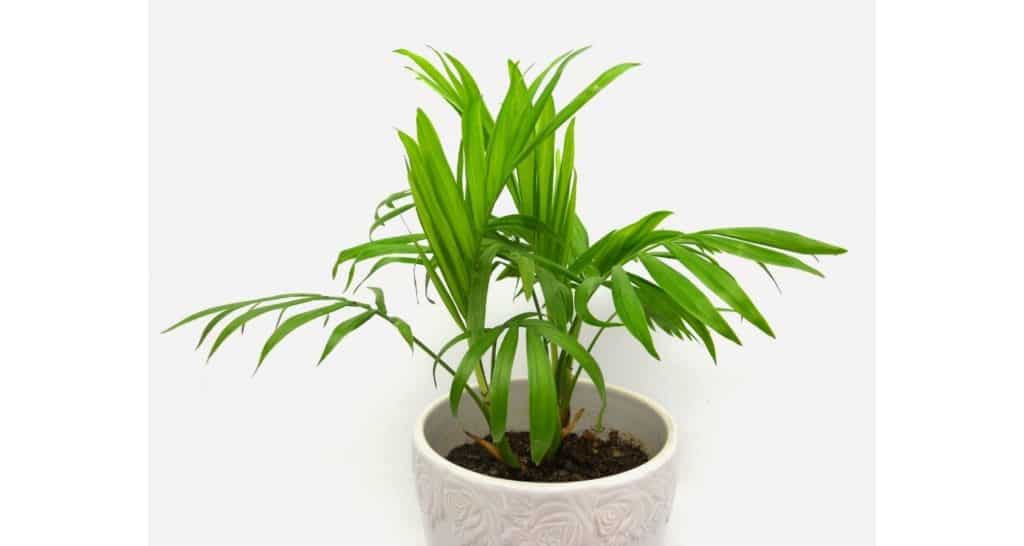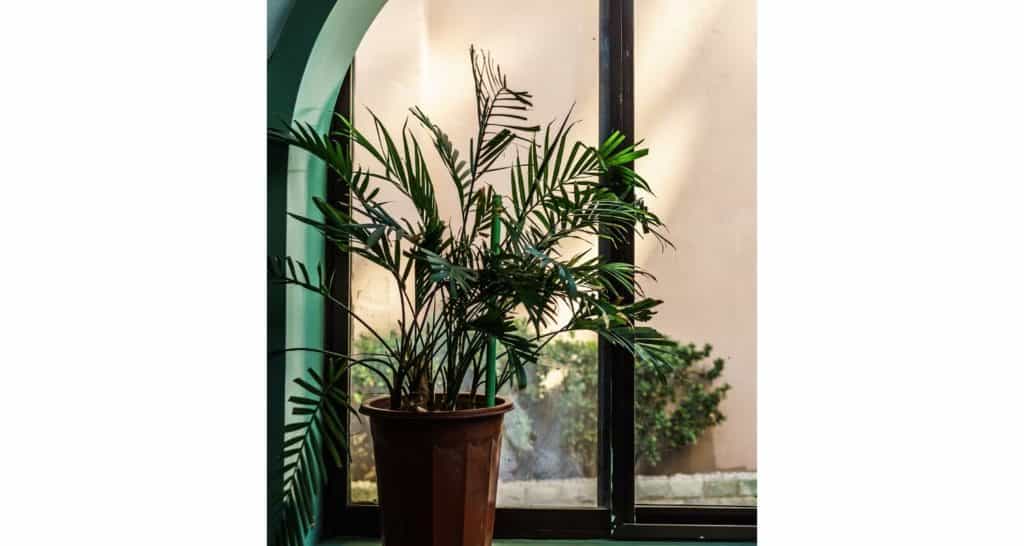Chamaedorea Elegans is a beautiful and elegant indoor plant. It was commonly found in parlors during the Victorian era, earning the name Parlor Palm. It is also known as the Neanthe Bella.
A healthy and happy Chamaedorea Elegans is a sight to behold. Under optimal conditions, the single-stemmed Chamaedorea Elegans grows up to 6 feet. The bright-to-dark green leaves have leaflets (pinnae) that resemble feathers.
Keeping an eye on the Chamaedorea Elegans is vital. When its green leaves begin curling, that is a sign that the conditions have become less than optimal.
Conditions that will cause the leaves of the Chamaedorea Elegans to curl are:
- Overwatering and underwatering
- Too much direct sunlight
- Low humidity
- Soggy soil
- Overfertilizing
- Fungal problems
- Pest infestation
- Salt and mineral build up from tap water
Providing the parlour palm with a warm, humid environment with bright indirect sunlight will uncurl the leaves after a few days.
Before we provide a quick care guide on the parlour palm, let’s cover the most common issues and their solutions. After all, being able to diagnose the problem will help you make your parlour palm happier.
Here are 8 reasons why the leaves of the Chamaedorea Elegans curl.
1. Underwatering Causes Chamaedorea Elegans Leaves To Curl
One of the most common reasons for curling leaves on the Chamaedorea Elegans is from underwatering.
Underwatering will cause stress on the plant, sometimes referred to as water stress, which is visibly shown by curling leaves.

Parlour palms are native to tropical regions which means this plant prefers a wet and humid environment. So underwatering will lead to dryness which this plant does not like.
Watering the plant more frequently and misting the leaves will encourage the leaves to uncurl over time.
2. Overwatering Causes Chamaedorea Elegans Leaves To Curl
Overwatering and misting too often or too much can cause the soil to become soggy. Poor-draining soil can also contribute to the sogginess along with a pot that does not have a drainage hole.
Soggy soil for any indoor plant can become a major issue overtime. This sogginess will eventually lead to root rot which can be fatal to a plant.
Damage to the roots is usually extensive by the time the leaves have curled since this means the leaves are not receiving enough moisture since the roots have begun rotting.
Typically plants do not need to be watered if the soil is still damp when you place your index finger 1 or 2 inches deep into the soil.
Once root rot develops, it can only be fixed by removing the rotten part of the plant. After the rotted roots have been removed the remaining plant can be repotted with indoor potting soil that allows for excess water to drain.
So be sure to not overwater the parlour palm as that can cause the leaves to curl.
3. Too Much Direct Sunlight Will Cause Chamaedorea Elegans Leaves To Curl
Parlour palms are native to tropical jungles. Given their short size – these palms are commonly found under the canopy of trees.
Parlour palms prefer a warm, humid environment that has plenty of bright, indirect sunlight. Similar to what a parlour palm would receive when growing underneath the jungle’s canopy.

If the parlour palm is located beneath a window that receives a lot of direct sunlight then the direct exposure may be too much. Excess direct sunlight will damage the plant and cause the leaves to curl.
By curling the leaves, the plant is trying to reduce the surface area exposed to sunlight.
The best solution is to place the parlour palm away from the window so it can still receive indirect sunlight. After a few days the leaves will uncurl if the direct sunlight was causing the leaves to curl.
4. Low Humidity Causes Chamaedorea Elegans Leaves To Curl
Chamaedorea Elegans thrive in humid environments. Unfortunately, most indoor spaces are rarely humid especially during colder months when the heater is turned on.
Not to mention air conditioners typically lower the room’s humidity so the plant will still be in less than ideal conditions during summer months.
Make sure to move the plant if the parlour palm is in a drafty walk way or near a heater vent. Typically the plant will uncurl its leaves when warm or dry air is not continually hitting its leaves.
Another solution is to mist the parlour palm’s leaves with water daily or place a humidifier near the plant. The humid air will uncurl the leaves over time.
5. Too Much Fertilizer Will Cause Chamaedorea Elegans Leaves To Curl
Chamaedorea Elegans do not need a lot of fertilizer and most indoor potting soil comes with a fair amount of nutrients. If you have been heavy-handed on the fertilizer then the leaves will curl.
Curling leaves can be a sign of too much fertilizer as the minerals will build up and affect the pH of the soil. The plant will not be able to absorb nutrients and water due to all the minerals in the soil which causes the leaves to curl.
Another symptom of over fertilizing is that the plant’s leaves may start spotting or have other discoloration along the edges or the veins. This discoloration is a sign that the plant is unable to absorb the nutrients it needs due to overfertilization.
6. Fungal Problems Cause Chamaedorea Elegans Leaves To Curl
Fungal problems caused by stem rot or phytophthora root rot typically occur during the summer. Common symptoms include blackened roots, wilting, yellowing leaves, and lesions on stems.
Fungal problems can be trickier to resolve and may require a fungal spray in order to fix the issue.
The best solution to fungal problems is preventative maintenance. Typically wet soil will lead to fungal growth. So fungal growth can be prevented as long as the soil is allowed dry in between watering.
7. Pests Cause Chamaedorea Elegans Leaves To Curl
Dust, poor air circulation, and dehydration make an ideal breeding ground for pests. Common pests that infest Chamaedorea Elegans are:
- Mealybugs: These pests attach their egg sacs to the leaves and stems. Once hatched and grown into adult bugs, they spread to other leaves, stems, and in the soil.
- Whitefly: This white-colored insect is found on the base of the leaf. It sucks nutrients from the leaves and excretes a sugary substance that becomes moldy. As the mold grows, it covers the leaves and blocks light absorption.
- Aphids: The palm aphid sucks the sap from the leaves and stem of the Chamaedorea Elegans. Like the whitefly, aphids excrete a sugary substance on the leaves that becomes moldy and blocks sunlight.
- Red spider mites: These insects form webbings and make the leaves look dusty and discolored. A light infestation can be treated. However, heavy infestation may mean getting rid of the plant to prevent any spread to other plants.
Common treatment for most indoor pests is to create a warm soapy water spray that can be applied directly onto the bugs and plants. This homemade insecticidal spray is safe to use on plants and safe to spray around kids and plants.
View this guide on how to make your own homemade insecticidal soapy spray.
Just make sure to use castile soap instead of any scented soaps or dish soaps. Most scented or dish soaps are actually a detergent which will damage the plant’s leaves.
8. Tap Water Causes Chamaedorea Elegans Leaves To Curl
It is common to use tap water when watering indoor house plants. Unfortunately, tap water typically contains salts and other minerals that cause a buildup over time in the soil.
Excessive salt and mineral build-up alters the soil pH and inhibits Chamaedorea Elegans from absorbing nutrients such as nitrogen.
Similar to over fertilizing the soil, excessive salt and mineral build up will cause the plant’s leaves to curl and discolor.
The best solution is to repot the plant with new soil and use distilled water.
You can still use tap water as long as you let the water sit overnight or for an hour so the salts and minerals can sink to the bottom of the water pail. Just make sure to not use the water at the bottom of the water pail since that’s where all the excess salts and minerals will be.
Chamaedorea Elegans Care Guide
You can fix the curling of Chamaedorea Elegans leaves by providing optimal conditions for the plant. Here is a basic care guide to properly take care of a Chamaedorea Elegans.
Watering
Keep the soil moist but not wet. Water the Chamaedorea Elegans when the soil is slightly dry.
Measure the soil’s moisture by sticking your index finger about 1 to 2 inches into the soil. If the soil is still moist then the plant does not need to be watered.
Make sure that the soil allows for drainage and that there is a drainage hole at the bottom of the pot. If the excess water cannot escape then the soil will be too wet which can lead to root rot.
Bright Indirect Light
The best lighting for Chamaedorea Elegans is birght indirect light. Similar to the palm being underneath a jungle canopy, these plants do not like having direct sunlight.
Place the plant near a window but not where the sunlight will hit the plant for more than a few hours a day.
Typically north or west facing windows are the preferred locations for tropical plants. However, any window will work as long as the plant does not receive too much direct sunlight.
The parlour palm will also not do well in dark corner or dark rooms. So give it the bright indirect light is loves!
High Humidity
Chamaedorea Elegans thrive in humid conditions. However, keep the plant away from extreme temperatures and humidity swings.
The ideal temperature is anywhere between 50 degrees and 80 degrees Fahrenheit. The ideal humidity is anywhere between 40 to 80 percent.
Misting the leaves during the day helps with the humidity. Misting also prevents the leaves from browning and becoming dusty.
Soil Drainage
Chamaedorea Elegans will not grow well and show signs of stress in poorly draining soil.
Ensure that the soil is well-draining to prevent root rot and nutrient deficiencies. Good indoor potting soil should not clump or become soggy after watering.
You may need to buy soil that has better drainage if you live in a humid area.
Fertilizer
Avoid putting too much fertilizer in the soil.
Much like seasoning food – you can always add more but it’s difficult or impossible to take the extra out.
Apply a weak fertilizer solution during spring-summer growing season.
Controlling Pest Infestation
There are a few options when it comes to treating a pest infestation.
There are commercial and DIY methods to treat mealy bugs, whitefly, aphids, red spider mites, fungus gnats, and scales infestations.
Here are some common solutions:
- Spray the plants with insecticide.
- Spray the soil surface with pesticides to destroy the adults and control larvae. Kill soil mealybugs using Malathion or Acephate.
- Neem oil is a natural alternative to chemical pesticides. It is effective in killing eggs, larvae, and adult pests.
- Spray or wipe the leaves with a homemade solution of dish-washing soap and water. A few drops of soap per quart of water will do. Apply every two days for two weeks or until the infestation clears.
- Spray the plant with a homemade apple cider vinegar (ACV) solution. Combine 3 ounces of water to 1 ounce ACV.
- Wipe the affected areas with rubbing alcohol.
Additional Tips
- Follow the instructions on the pesticide labels.
- Ensure that the soil is rated for indoor use and drains well before using a pesticide.
- Remove any saucers under the pots to prevent phytotoxicity.
Final Thoughts on Fixing Chamaedorea Elegans Leaves Curling
Chamaedorea Elegans is beginner friendly plant since it’s a relatively low maintenance indoor plant. It does not need much to keep it happy, other than ensuring that its environment is optimal.
Just make sure to pay attention to the plant. Curling leaves is an early sign of stress so there are a few conditions to watch out for.
Pay attention to the humidity, watering schedule, amount of sunlight, soil, and pests in order to make sure the parlour palm is happy.
Once all the parlour palm’s conditions are met, it will greet you with luscious green leaves for many years to come.

